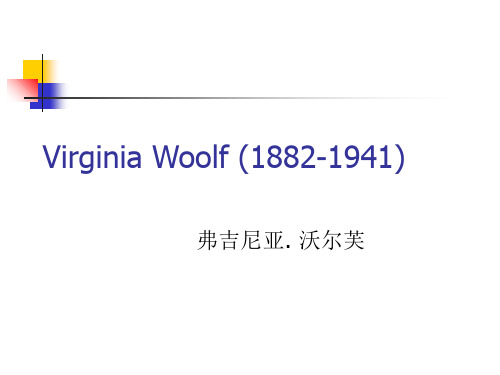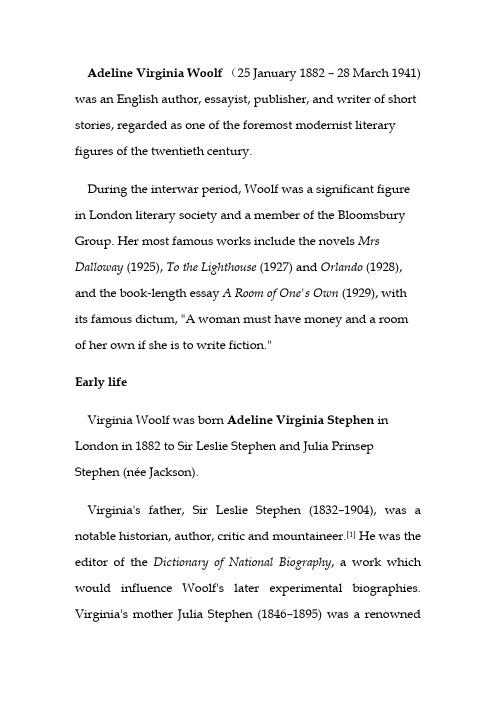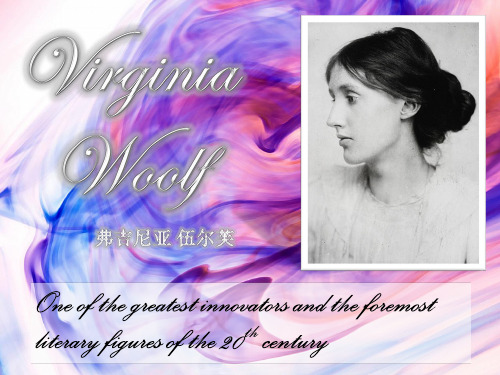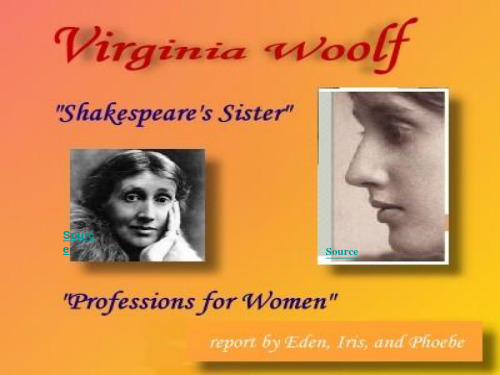2.1 Modern Fiction - Virginia Woolf
- 格式:pdf
- 大小:1.85 MB
- 文档页数:9

064《名家名作》·研究[摘 要] 以《达洛维夫人》为研究对象,探讨伍尔夫通过书写疾病,借以疾病隐喻指出当时社会落后的性别意识观念影响两性健康发展。
同时,伍尔夫通过作品结局提出,只要人们具备主体性,终能在落后的性别观念束缚之中破茧而出。
[关 键 词] 疾病书写;性别意识;《达洛维夫人》 《达洛维夫人》疾病书写与性别意识研究薛子彤 高红梅《达洛维夫人》是女性主义者作家弗吉尼亚·伍尔夫的作品,其中有大量对疾病的描述。
伍尔夫曾在《论生病》中感叹“人们原本以为小说本该奉献给流感,史诗本该忠实于伤害,颂歌应献身给肺炎,抒情诗则须尽心于牙疼”①,可见在伍尔夫的写作观中,疾病对作者洞察到的事物本象、剖析出的社会制度有着不同寻常的表现力。
通过疾病书写觉察与揭示的社会性别意识形态,正是伍尔夫持续剖析社会制度的一种表现形式。
伍尔夫曾言,或许公众会觉得一部以流感为主题的小说缺乏情节,公众会抱怨作品中没有爱情,但恰恰相反,“疾病经常穿着爱情的伪装,玩着同样隐秘的花招”②,可见疾病书写在伍尔夫创作中有着意味深长的隐喻。
《达洛维夫人》中大篇幅详写的塞普蒂默斯的弹震症,多次略写的达洛维夫人的心脏病导致病弱的身体状态,追究其人物病因、病状背后的隐喻,就能捕捉到其下隐含着伍尔夫对当时社会性别意识潜在问题的揭示。
一、疾病的显现:社会中迷失的男女伍尔夫曾在《论生病》中谈到生病这种事情司空见惯,却很少有作家将其写入作品之中,可见其对疾病书写的重视。
因而在伍尔夫的作品之中,经常出现对人物疾病的描述。
展示塞普蒂默斯和克拉丽莎·达洛维的病情,便是《达洛维夫人》中的主要情节。
作品中的塞普蒂默斯曾主动申请参战,可他在战场之上变得愈加麻木,后来他结了婚,状态却一日不如一日,他突然意识到自己犯了错,“埃文思牺牲时他毫不在乎;那是最大的罪过……他不爱妻子却和她结了婚……他全身密密麻麻地布满了罪恶堕落的疤痕……人性对这样卑鄙无耻的人的判决就是死刑。


Adeline Virginia Woolf(25 January 1882 – 28 March 1941) was an English author, essayist, publisher, and writer of short stories, regarded as one of the foremost modernist literary figures of the twentieth century.During the interwar period, Woolf was a significant figure in London literary society and a member of the Bloomsbury Group. Her most famous works include the novels Mrs Dalloway (1925), To the Lighthouse (1927) and Orlando (1928), and the book-length essay A Room of One's Own (1929), with its famous dictum, "A woman must have money and a room of her own if she is to write fiction."Early lifeVirginia Woolf was born Adeline Virginia Stephen in London in 1882 to Sir Leslie Stephen and Julia Prinsep Stephen (née Jackson).Virginia's father, Sir Leslie Stephen (1832–1904), was a notable historian, author, critic and mountaineer.[1] He was the editor of the Dictionary of National Biography, a work which would influence Woolf's later experimental biographies. Virginia's mother Julia Stephen (1846–1895) was a renownedbeauty, born in India to Dr. John and Maria Pattle Jackson. Woolf was educated by her parents in their literate and well-connected household at 22 Hyde Park Gate, Kensington. Her parents had each been married previously and been widowed, and, consequently, the household contained the children of three marriages.According to Woolf's memoirs, her most vivid childhood memories were not of London but of St. Ives in Cornwall, where the family spent every summer until 1895. The Stephens' summer home, Talland House, looked out over Porthminster Bay, and is still standing today, though somewhat altered. Memories of these family holidays and impressions of the landscape, especially the Godrevy Lighthouse, informed the fiction Woolf wrote in later years, most notably To the Lighthouse.The sudden death of her mother in 1895, when Virginia was 13, and that of her half-sister Stella two years later, led to the first of Virginia's several nervous breakdowns. She was, however, able to take courses of study (some at degree level) in Greek, Latin, German and history at the Ladies’ Department of King’s College London between 1897 and 1901,and this brought her into contact with some of the early reformers of women’s higher education such as Clara Pater, George Warr and Lilian Faithfull (Principal of the King’s Ladies’ Department and noted as one of the Steamboat ladies).[4] Her sister Vanessa also studied Latin, Italian, art and architecture at King’s Ladies’ Department.The death of her father in 1904 provoked her most alarming collapse and she was briefly institutionalised.[3] Modern scholars (including her nephew and biographer, Quentin Bell) have suggested[5] her breakdowns and subsequent recurring depressive periods were also influenced by the sexual abuse to which she and her sister Vanessa were subjected by their half-brothers George and Gerald Duckworth (which Woolf recalls in her autobiographical essays A Sketch of the Past and 22 Hyde Park Gate).Throughout her life, Woolf was plagued by periodic mood swings and associated illnesses. Though this instability often affected her social life, her literary productivity continued with few breaks throughout her life.BloomsburyAfter the death of their father and Virginia's second nervous breakdown, Vanessa and Adrian sold 22 Hyde Park Gate and bought a house at 46 Gordon Square in Bloomsbury.Woolf came to know Lytton Strachey, Clive Bell, Rupert Brooke, Saxon Sydney-Turner, Duncan Grant, Leonard Woolf and Roger Fry, who together formed the nucleus of the intellectual circle of writers and artists known as the Bloomsbury Group. Several members of the group attained notoriety in 1910 with the Dreadnought hoax, which Virginia participated in disguised as a male Abyssinian royal. Her complete 1940 talk on the Hoax was discovered and is published in the memoirs collected in the expanded edition of The Platform of Time (2008).In 1907 Vanessa married Clive Bell, and the couple's interest in avant garde art would have an important influence on Woolf's development as an author.[6]Virginia Woolf married writer Leonard Woolf in 1912. Despite his low material status (Woolf referring to Leonard during their engagement as a "penniless Jew") the couple shared a close bond. Indeed, in 1937, Woolf wrote in her diary: "Love-making –after 25 years can’t bear to be separate ... yousee it is enormous pleasure being wanted: a wife. And our marriage so complete." The two also collaborated professionally, in 1917 founding the Hogarth Press, which subsequently published Virginia's novels along with works by T.S. Eliot, Laurens van der Post, and others.[7] The Press also commissioned works by contemporary artists, including Dora Carrington and Vanessa Bell.The ethos of the Bloomsbury group encouraged a liberal approach to sexuality, and in 1922 she met the writer and gardener Vita Sackville-West, wife of Harold Nicolson. After a tentative start, they began a sexual relationship, which, according to Sackville- West, was only twice consummated.[8] In 1928, Woolf presented Sackville-West with Orlando, a fantastical biography in which the eponymous hero's life spans three centuries and both genders. Nigel Nicolson, Vita Sackville-West's son, wrote "The effect of Vita on Virginia is all contained in Orlando, the longest and most charming love letter in literature, in which she explores Vita, weaves her in and out of the centuries, tosses her from one sex to the other, plays with her, dresses her in furs, lace and emeralds, teases her, flirts with her, drops a veil of mist around her".[9] Aftertheir affair ended, the two women remained friends until Woolf's death in 1941.WorkWoolf began writing professionally in 1900, initially for the Times Literary Supplement with a journalistic piece about Haworth, home of the Brontë family.[10] Her first novel, The Voyage Out, was published in 1915 by her half-brother's imprint, Gerald Duckworth and Company Ltd. This novel was originally entitled Melymbrosia, but Woolf repeatedly changed the draft.Woolf went on to publish novels and essays as a public intellectual to both critical and popular success..Woolf is considered one of the greatest innovators in the English language. In her works she experimented with stream-of-consciousness and the underlying psychological as well as emotional motives of characters. Woolf's reputation declined sharply after World War II, but her eminence was re-established with the surge of Feminist criticism in the 1970s.[14]Woolf's work was criticized for epitomizing the narrow world of the upper-middle class English intelligentsia. She was also criticized by some as an anti-Semite, despite her being happily married to a Jewish man. This anti-Semitism is drawn from the fact that she often wrote of Jewish characters in stereotypical archetypes and generalizations, including describing some of her Jewish characters as physically repulsive and dirty.[15].The intensity of Virginia Woolf's poetic vision elevates the ordinary, sometimes banal settings – often wartime environments – of most of her novels. For example, Mrs Dalloway (1925) centres on the efforts of Clarissa Dalloway, a middle-aged society woman, to organise a party, even as her life is paralleled with that of Septimus Warren Smith, a working-class veteran who has returned from the First World War bearing deep psychological scars.[19]Woolf was inspired to write Flush: A Biography book from the success of the Rudolf Besier play, The Barretts of Wimpole Street. In the play, Flush is on stage for much of the action. The play was produced for the first time in 1932 by actress Katharine Cornell.Her last work, Between the Acts (1941) sums up and magnifies Woolf's chief preoccupations: the transformation of life through art, sexual ambivalence, and meditation on the themes of flux of time and life, presented simultaneously as corrosion and rejuvenation—all set in a highly imaginative and symbolic narrative encompassing almost all of English history. .Her works have been translated into over 50 languages, by writers such as Jorge Luis Borges and Marguerite Yourcenar. DeathAfter completing the manuscript of her last novel, Between the Acts, Woolf fell into a depression similar to that which she had earlier experienced. The onset of World War II, the destruction of her London home during the Blitz, and the cool reception given to her biography of her late friend Roger Fry all worsened her condition until she was unable to work.[12] On 28 March 1941, Woolf put on her overcoat, filled its pockets with stones, and walked into the River Ouse near her home and drowned herself. Woolf's body was not found until 18 April 1941.[25] Her husband buried her cremated remainsunder an elm in the garden of Monk's House, their home in Rodmell, Sussex.In her last note to her husband she wrote: Dearest, I feel certain that I am going mad again. I feel we can't go through another of those terrible times. And I shan't recover this time. I begin to hear voices, and I can't concentrate. So I am doing what seems the best thing to do. You have given me the greatest possible happiness. You have been in every way all that anyone could be. I don't think two people could have been happier 'til this terrible disease came. I can't fight any longer. I know that I am spoiling your life, that without me you could work. And you will I know. You see I can't even write this properly. I can't read. What I want to say is I owe all the happiness of my life to you. You have been entirely patient with me and incredibly good. I want to say that –everybody knows it. If anybody could have saved me it would have been you. Everything has gone from me but the certainty of your goodness. I can't go on spoiling your life any longer. I don't think two people could have been happier than we have been.。



毕业设计(论文)开题报告题目:简·奥斯汀与弗吉尼亚·伍尔芙的女性主义思想的比较分析学院:外国语学院专业:英语学生姓名:学号:200604010320指导教师:2009年3月12日开题报告填写要求1.开题报告(含“文献综述”)作为毕业论文答辩委员会对学生答辩资格审查的依据材料之一。
此报告应在指导教师指导下,由学生在毕业论文工作前期内完成,经指导教师签署意见及所在专业审查后生效。
2.开题报告内容必须用黑墨水笔工整书写或按此电子文档标准格式(可从外语系网页上下载)打印,禁止打印在其它纸上后剪贴,完成后应及时交给指导教师签署意见。
3.“文献综述”应按论文的格式成文,并直接书写(或打印)在本开题报告第一栏目内,学生写文献综述的参考文献应不少于15篇(不包括辞典、手册),其中至少应包括5-8篇外文资料。
对于重要得参考文献应附原件复印件,作为附件装订在开题报告的最后。
4.统一用A4纸,并装订单独成册,随《毕业设计论文》等资料装入文件袋中。
1.文献综述:结合毕业论文课题情况,根据所查阅的文献资料,撰写2500-3000字左右的文献综述,文后应列出所查阅的文献资料。
简·奥斯汀是十八世纪末十九世纪初英国现实主义女作家,给世人留下了《傲慢与偏见》,《爱玛》,《理智与情感》等六部完整的作品,奠定了她在英国文坛不可动摇的地位,被誉为“女性中的莎士比亚”,也被称为十九世纪最伟大的女性作家。
弗吉尼亚·伍尔芙是二十世纪最杰出的女作家,是现代主义与意识流小说的重要代表之一,英国批判现实主义的主要奠基者。
奥斯汀与伍尔芙都是女性主义的先驱。
她们的女性主义思想在她们各自的代表作品《傲慢与偏见》和《一间自己的房间》中有好的体现。
近些年来,一些学者致力于研究她们的作品中所展现的女性主义思想,并且有了一定的成果。
女性主义可以追溯到欧洲文艺复兴和宗教改革运动时期。
当时的人文主义反对神权和封建等级制度,提倡“天赋人权”,实际上这已潜在地包涵了“女性人权”的观念。